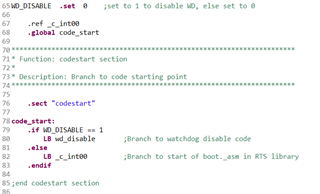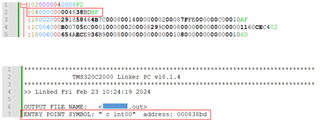Dear experts,
As far as I understand, the address 0x80000 (I'm using TI28377D) contains four-byte values: the "entry point symbol," which can be referred from the .map file. For example, the symbol name is _c_int00 @ 0x8378A.

In my project, my built .hex file does not contain this information, which prevents normal booting under standalone mode.

My question is: How can this symbol address be automatically embedded through the command line? (I have tried manually adding the symbol address in the hex file, and the operation was normal under standalone mode.)
According to the reference spru514, I have added the link option --rom_model, but the entry point symbol is still not embedded.
Here is the partial command I've used in the Makefile:
-m $(PROJECT_NAME).map -e _c_int00 --rom_model -o $(PROJECT_NAME).$(BINARY_SUFFIX)
Am I missing any commands?
Thanks,
C.C, Liu








